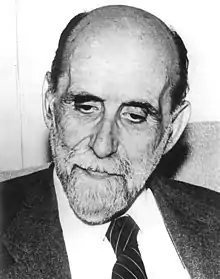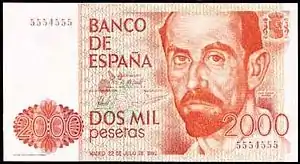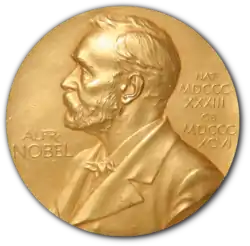Juan Ramón Jiménez
Juan Ramón Jiménez Mantecón (Spanish pronunciation: [xwan raˈmoŋ xiˈmeneθ manteˈkon];[lower-alpha 1] 23 December 1881 – 29 May 1958) was a Spanish poet, a prolific writer who received the Nobel Prize in Literature in 1956[1] "for his lyrical poetry, which in the Spanish language constitutes an example of high spirit and artistic purity". One of Jimenez's most important contributions to modern poetry was his advocacy of the concept of "pure poetry."
Juan Ramón Jiménez | |
|---|---|
 | |
| Born | Juan Ramón Jiménez Mantecón 23 December 1881 Moguer, Huelva, Andalucia, Spain |
| Died | 29 May 1958 (aged 76) San Juan, Puerto Rico |
| Occupation | poet |
| Nationality | Spanish |
| Genre | poetry |
| Notable awards | Nobel Prize in Literature 1956 |
| Spouse | Zenobia Camprubí |
Biography
Juan Ramon Jimenez was born in Moguer, near Huelva, in Andalucia, on 23 December 1881.[2] He was educated in the Jesuit institution of San Luis Gonzaga, in El Puerto de Santa María, near Cadiz. Later, he studied law and painting at the University of Seville, but he soon discovered that his talents were better used for writing.[3] Then he dedicated to the literary influenced by Rubén Darío and the simbolism.[3] He published his first two books at the age of eighteen, in 1900. The death of his father the same year devastated him, and a resulting depression led to his being sent first to France, where he had an affair with his doctor's wife, and then to a sanatorium in Madrid staffed by novitiate nuns, where he lived from 1901 to 1903. In 1911 and 1912, he wrote many erotic poems depicting romps with numerous females in numerous locales. Some of them alluded to sex with novitiates who were nurses. Eventually, apparently, their mother superior discovered the activity and expelled him, although it is not known whether the sexual activity described in his poems actually occurred.
The main subjects of many of his other poems were music and color, which, at times, he compared to love or lust.
He suffered a mental breakdown and depression, so he stayed hospitalised in France and Madrid.[3] He celebrated his home region in his prose poem about a writer and his donkey called Platero and I (1914). In 1916 he and Spanish-born writer and poet Zenobia Camprubí were married in the United States. Zenobia became his indispensable companion and collaborator.
Upon the outbreak of the Spanish Civil War, he and Zenobia went into exile in Puerto Rico, where he settled in 1946. Jiménez was hospitalized for eight months due to another deep depression. He later became a Professor of Spanish Language and Literature at the University of Puerto Rico. His literary influence on Puerto Rican writers strongly marks the works of Giannina Braschi, René Marqués, Aurora de Albornoz, and Manuel Ramos Otero.[4] The university named a building on campus and a writing program in his honor. He was also a professor at the University of Miami in Coral Gables, Florida. While living in Coral Gables he wrote "Romances de Coral Gables". In addition, he was a professor in the Department of Spanish and Portuguese at the University of Maryland, which renamed Jimenez Hall for him in 1981.
In 1956, he received the Nobel Prize in Literature; two days later, his wife died of ovarian cancer. Jiménez never recovered from the emotional devastation, and he died two years afterwards, on 29 May 1958, in the same clinic where his wife had died. Both are buried in his hometown of Moguer, Spain.
Although he was primarily a poet, Jiménez' prose work Platero y yo (1917; "Platero and I"; Platero is a donkey) sold well in Latin America and in translation won him popularity in the USA. He also collaborated with his wife in the translation of the Irish playwright John Millington Synge's Riders to the Sea (1920). His poetic output during his life was immense. Among his better known works are Sonetos espirituales 1914–1916 (1916; “Spiritual Sonnets, 1914–15”), Piedra y cielo (1919; “Stones and Sky”), Poesía, en verso, 1917–1923 (1923), Poesía en prosa y verso (1932; “Poetry in Prose and Verse”), Voces de mi copla (1945; “Voices of My Song”), and Animal de fondo (1947; “Animal at Bottom”). A collection of 300 poems (1903–53) in English translation by Eloise Roach was published in 1962.

Jiménez in popular culture
- A quotation from Jiménez, "If they give you ruled paper, write the other way," is the epigraph to Ray Bradbury's novel Fahrenheit 451 (1953).
- In 1968, the Spanish film director Alfredo Castellón adapted Jiménez's novel "Platero and I" into a movie by the same title.
- The Spanglish novel Yo-Yo Boing! (1998) by the Puerto Rican author Giannina Braschi features a scene in which poets and artists debate Jiménez's genius versus that of other Spanish language poets Francisco de Quevedo, Luis de Góngora, Rubén Darío, Pablo Neruda, Federico García Lorca, and Julia de Burgos.[5]
- A rock band in Spain is named "Platero y tú" after Jiménez's novel
Streets named after Jiménez
Several streets have been named after Jiménez, including one in Madrid[6] and one in Valencia.[7]
See also
- Spanish poetry
- Modernismo
- Puerto Rican poetry
- Puerto Rican literature
- Sonnet
Notes
- In isolation, Ramón is pronounced [raˈmon].
References
- The Editors of Encyclopædia Britannica. "Juan Ramón Jiménez".
- Mateo Pérez, Manuel (November 10, 2010). "Moguer y Juan Ramón Jiménez". El Mundo (in Spanish). Retrieved February 17, 2018.
- "Juan Ramón Jiménez. Biografía". Instituto Cervantes (in Spanish). Madrid. March 2016. Retrieved February 17, 2018.
- "Elemental Creature". The Times Literary Supplement (in Spanish). March 10, 2015. Archived from the original on April 21, 2016. Retrieved February 17, 2018.
His lyrical and philosophical work influencing Puerto Rican writers such as Manuel Ramos Otero and René Marqués.
- Braschi, Giannina (1998). Sommer, Doris (ed.). Yo-Yo Boing!. Latin American Literary Review Press. p. 205. ISBN 0-935480-97-8.
- "Calle de Juan Ramón Jiménez". Callejero.net (in Spanish). Madrid: Hispanetwork Publicidad y Servicios, SL. Retrieved February 17, 2018.
- "C/ Juan Ramón Jiménez". Callejero.net (in Spanish). Valencia: Hispanetwork Publicidad y Servicios, SL. Retrieved February 17, 2018.
Bibliography
- de Albornoz, Aurora, ed. 1980. Juan Ramón Jiménez. Madrid: Taurus.
- Blasco, F. J. 1982. La Poética de Juan Ramón Jiménez. Desarrollo, contexto y sistema. Salamanca.
- Campoamor González, Antonio. 1976. Vida y poesía de Juan Ramón Jiménez. Madrid: Sedmay.
- Campoamor González, Antonio. 1982. Bibliografía general de Juan Ramón Jiménez. Madrid: Taurus.
- El Cultural. 14 Jun 2007. Los poemas eróticos de Juan Ramon Jiménez. Aparece Libros de amor. Conoce los poemas del JRJ más lujurioso
- Diario de Córdoba. 6 Jan 2007. ´Libros de amor´ descubre a un Juan Ramón Jiménez erótico
- Díez-Canedo, E. 1944. Juan Ramón Jiménez en su obra. México City.
- Guardian (London). 19 Jun 2007. My sex in the convent - by Nobel poet
- Font, María T. 1973. Espacio: autobiografía lírica de Juan Ramón Jiménez. Madrid.
- Guerrero Ruiz, J . 1961. Juan Ramón de viva voz. Madrid.
- Gullón, R. 1958. Conversaciones con Juan Ramón Jiménez. Madrid.
- Jensen, Julio, 2012, The Poetry of Juan Ramón Jiménez. An Example of Modern Subjectivity. Copenhagen.
- Juliá, M. 1989. El universo de Juan Ramón Jiménez. Madrid.
- Olson, P.R. 1967. Circle of Paradox: time and essence in the poetry of Juan Ramon Jimenez. Baltimore.
- Palau de Nemes, G. 1974. Vida y obra de Juan Ramón Jiménez. 2/e. 2 v. Madrid: Gredos.
- Predmore, Michael P. 1966. La obra en prosa de Juan Ramón Jiménez. Madrid: Gredos.
- Salgado, M. A. 1968. El arte polifacético de las caricaturas líricas juanramonianas. Madrid.
External links
| Wikimedia Commons has media related to Juan Ramón Jiménez. |
| Spanish Wikisource has original text related to this article: |
| Wikiquote has quotations related to: Juan Ramón Jiménez |
- Works by Juan Ramón Jiménez at Project Gutenberg
- Works by Juan Ramón Jiménez at LibriVox (public domain audiobooks)


- Works by or about Juan Ramón Jiménez at Internet Archive
- Fundacion Casa-Museo Zenobia y Juan Ramón Jiménez
- Nobel Prize Acceptance Speech
- Juan Ramón Jiménez on Nobelprize.org

- Juan Ramón Jiménez at Find a Grave

- Juan Ramón Jiménez at IMDb

- Juan Ramon Jimenez recorded at the Library of Congress for the Hispanic Division’s audio literary archive on May 17, 1947, Sept. 29, and Dec. 8, 1949
